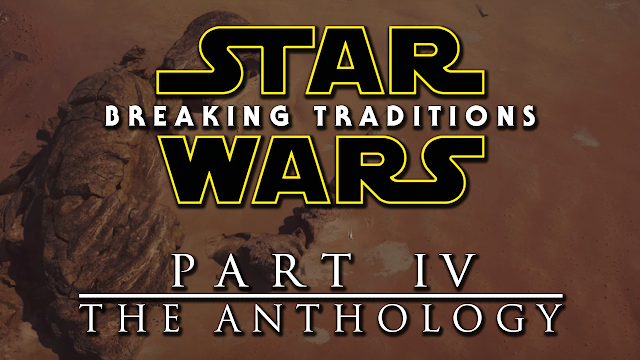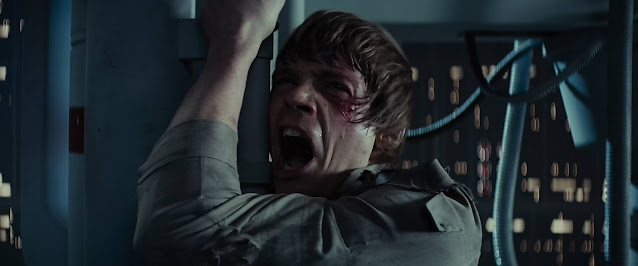Breaking Traditions in Star Wars - Part IV (The Anthology)
We've arrived to the last part of this series! Don't forget to check out the first three, detailing the Original Trilogy, the Prequels and the Sequels.
It's only natural that this part is a bit longer, since the very nature of the Anthology films results in many traditions being left behind.
Let's start by those differences with the Skywalker Saga that occur in both Rogue One and Solo:
No Opening Crawl:
No wipes between scenes:
To set them
apart from the Saga film, the Anthology had to shed certain practices. The
most noticeable among them is the lack of the signature yellow Opening Crawl, which
makes a lot of sense since they're not numbered entries.
The Star Wars Episodes are also known for using wipes of all shapes as transitions between some scenes. While all the TV series have made use of this technique, the two Anthology films didn’t.
At one point during editing, Rogue
One was tested with some, until they finally decided to
discard them entirely. Solo followed .
Of course,
there’s still one wipe in each of these films: both still close with an iris (which is a circular wipe) as they go to the end credits.
Time skip within the films:
As explored
earlier, there are significant time jumps in galactic history, but they usually
happen between film, not within. Once each Saga episode starts, the
narrative will only span a few days, maybe weeks at the most.
The
Anthology format allows for more freedom in this respect. Both of them start with
a prologue set 13 years before Episode IV, displaying our heroes’ youth. After that, they make a significant time skip (Solo jumps three years ahead and Rogue
One skips the full thirteen).
No introductory text:
Endearingly,
the “A long time ago…” text is still used for the Anthology films. And even
though Solo lacks the intro Crawl from the Saga films, it still gets three short written statements before the film opens, done in the same style of the “A
long time…” card and explaining a bit of the backstory, essentially serving the same function as a
classic crawl.
Rogue
One doesn’t have any.
It jumps right to the opening sequence.
No “STAR WARS” logo:
This is the
only film where the words “STAR WARS” don’t actually appear onscreen.
Though its
full name is Rogue One: A Star Wars Story, the title card used on the
intro limits itself to the “ROGUE ONE” portion.
It’s not a
set format for the Anthology, though, since Solo does use the complete
title, as you'll see bellow.
No new themes by John Williams:
One of the
most spectacular feats in film history is John Williams scoring the complete Skywalker Saga, creating dozens of leitmotifs and incidental music
for each Episode. Since he’s only human (allegedly, I’m still not sure), it was
agreed that he wouldn’t score projects outside of I-XI (He did create a suite
for the Galaxy’s Edge Theme Park, though).
In any
case, Solo also had the honor of getting an orchestral suite specially
composed by Williams, with completely new material for the film, "The Adventures of Han". Maybe he
couldn’t resist the opportunity to finally create a motif for an iconic
character who never had one. Though the other original themes of the score are composed by John Powell, Williams piece becomes the driving musical theme of the film.
Rogue
One didn’t get to
have this, though. All new music is written by Michael Giacchino. He does use many of John Williams' classic themes, but this is the only film
released so far in which the Maestro himself hasn’t contributed any new pieces.
Luckily, we still haven't arrived to that dreaded moment where no Williams themes are used for a piece of Star Wars media. The Mandalorian (which has an excellent original score, as we all know) came very close, but now it has included The March of the Resistance twice and then Yoda's Theme. Hopefully that's a signal that more references to JW goodies will come to the show.
It uses intertitles to introduce its locations:
A classic
cinematographic device which the Saga films never used are the intertitles:
pieces of text that give us information, often about time or space.
Rogue
One sets itself
apart when it uses them to identify the locations as they are introduced,
excepting Lah’mu and Mustafar. Since the following Anthology entry didn’t use
them, this remains an unique characteristic of this particular film.
Interestingly,
Solo uses one intertitle for a reason that Rogue One doesn’t: to
inform us about time instead of space. An onscreen text states that a 3 years
time jump has taken place.
No chase sequence:
Just as much as it's indebted to westerns or Kurosawa, Star Wars owes a lot to
George Lucas’ lifelong passion for vehicles. In one of his DVD Audio Commentary tracks, he states that he loves speed and thus he always puts at least one chase or
a race on each Episode. Indeed, the original six films all feature vehicular fun.
All the
Sequels continue with the tradition, and Solo wouldn’t be about Han if it hadn’t many. Rogue One, on the other hand, lacks a
pursuit sequence.
Nobody yells "Nooooooo":
You know the one. I don’t mean just a regular “No”,
but that desperate, prolonged scream that is a major staple of the franchise, famously
said by Luke on The Empire Strikes Back and Vader in Revenge of the
Sith, but actually shouted by many characters in all the Saga films and Solo.
But after some examination, I realized that nobody says it in Rogue One. Yes, like probably every film ever, there are many instances of the word “No” being spoken, some even painful, but none of them are close to that long, Star Wars-y shriek of anguish we are familiar with.
It doesn’t open in space:
The device of the Opening Crawl means every Saga film has to start in space, showing us ships and planets before the action going on within them.
Though Rogue One has no crawl, it pretty much replicates a traditional opening, beginning in space as Krennic’s ship travels towards Lah’mu. Notice how the music starts with a jump scare meant to resemble the bombastic intro of the Main Titles Theme, and that even the composition of the shot is almost identical to the original film’s, with the moon in the same section of the frame as Tatooine’s moon (see this PART first picture).
Solo doesn’t start in space, though. After the introductory text we instead jump to a series of closeup shots of a speeder in Corellia. This is likely a narrative choice: Han yearns to fly among the stars, but he’s not quite there yet.
The title card doesn’t appear among the stars either. It’s also not a yellow outline:
Even though Rogue One’s title card doesn’t appear at the very beginning like in the Saga, and we first see a prologue sequence set within a planet, we go back to a starry background as the logo reveals itself.
Solo’s title card doesn’t materialize on space. Instead, it moves towards the camera in a wide shot of Corellian streets.
The overall treatment of the logo is also different. Rogue One’s uses a yellow outline, just like “STAR WARS” in the numbered episodes. Solo’s title card isn’t an outline, but it’s instead styled in the manner of a flickering hologram. In any case, it’s still yellow, though this one has a more orange tint than usual.
No Force Theme, mention of the Jedi or the Force:
This one
always makes me weep. To me, the Force Theme is the actual Star Wars
main musical cue (expect a full article on it eventually). Though I knew Solo’s
world was far removed from the Force itself, I thought there was a chance that the theme could be used to represent Legacy elements, much like one of its final trailers
did. Alas, it was not to be, making this one the first, and so far only
installment where the iconic piece is fully absent.
Of course,
it makes some sense: this is also the only film where the Jedi aren’t
mentioned at all. The Force isn’t nominally alluded to either, but it does make an
appearance as Maul summons his weapon. Even in this “Jediless” section of the
canon, lightsabers and the Force are still an unbroken tradition (see also: The
Mandalorian).
No R2-D2 and C-3PO:
Since the
only characters to be in every Skywalker Saga film also show up in Rogue
One, Solo becomes the only film where the duo doesn’t make an appearance.
At least,
many astromechs and protocol droids are present and, more importantly, Anthony
Daniels is also featured, so he can still claim to be on every film, something
nobody else can say.
No Skywalker:
We all know
that the main difference between a Saga film and the Anthology ones are that
the later don’t focus on the Skywalker family.
Still, that
didn’t stop the patriarch, in his Vader persona, to appear briefly but
prominently in Rogue One, leaving Solo as the only one with no
member of the clan. Of course, Han himself would eventually marry into the
family, so…
The final shot is a closeup:
We’ve come
up with some distinctive closing shots in the article, but still, they’re all
very wide shots. Just as Solo is the only film to open with a closeup,
it’s also the only that closes with one.
And that's it for this series. Remember to comment what did you think of this feature, if you spotted something I missed or if you have ideas for similar things you'd like me to do.


















Comments
Post a Comment